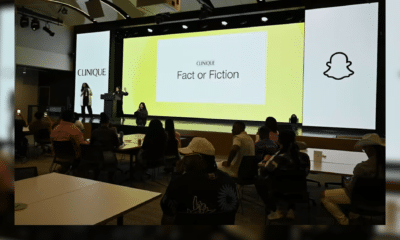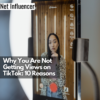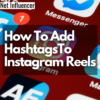-
Brand
The In-Person Advantage: How Eryn Vargo Built Mom Commerce Media by Connecting Mothers and Businesses Face-to-Face
April 16, 2025Mom Commerce Media generated enough revenue to triple its business since 2021 by implementing a strategy...
-
Strategy
The Lighthouse: An Investment That’s Tailor-Made for Creators
April 16, 2025The Lighthouse, a physical campus occupying a renovated 1937 post office in Venice, California, represents Whalar...
-
Influencer
MrBeast Responds To Complaints About Las Vegas Event
April 16, 2025MrBeast, whose real name is Jimmy Donaldson, responded to a complaint on social media, acknowledging the...
-
Platform
LinkedIn Unveils ‘Create On LinkedIn’ Hub To Help Professionals Boost Content Strategy
April 16, 2025LinkedIn has introduced a “Create on LinkedIn” hub designed to help professionals develop better content, understand...
-
Platform
TikTok Launches First SME Council To Empower Small UK Businesses
April 16, 2025TikTok has established its first Small and Medium Enterprise (SME) Council in the UK, bringing together...
-
Commentary
Creator Pay Transparency: A Win-Win For Brands And Influencers
April 16, 2025New research reveals that pay transparency in the creator economy benefits both brands and influencers, helping...
-
Platform
Meta Slams ‘Weak’ FTC Lawsuit As Ignoring Competition From TikTok
April 16, 2025Meta is facing an antitrust trial that began on Monday, April 14, as the U.S. Federal...
-
Commentary
Don’t Miss These Creator Economy Events In May 2025!
April 16, 2025Creator economy event season continues across the United States this May, following notable industry gatherings earlier...
-
Technology
Sprout Social Launches AI-Powered Influencer Marketing Platform
April 15, 2025Sprout Social has unveiled a new influencer marketing platform, featuring a refreshed design and new AI-driven...
-
Agency
Moburst’s Kitcaster Acquisition Signals Push Into Podcast Marketing
April 15, 2025Mobile-first digital marketing agency Moburst has acquired podcast booking agency Kitcaster as podcast listenership grows worldwide....
-
Brand
L’Oréal Appoints WPP Beauty Tech Labs As Exclusive Influencer Agency For ANZ Portfolio
April 15, 2025L’Oréal announced the appointment of WPP Beauty Tech Labs as its exclusive advocacy and influencer agency...
-
Commentary
Podcast Listeners Becoming Key Driver Of Music Industry Growth
April 15, 2025Luminate Insights reports that approximately 40% of the U.S. population listens to podcasts, with 26% tuning...
-
Commentary
Majority Of Consumers Believe Meta Holds Social Media Monopoly As FTC Takes Company To Court
April 15, 2025A new poll conducted by Forrester Research indicates that a majority of consumers agree with the...
-
Commentary
Beyond Scrolling: How Gen Z Uses Social Media To Connect, Curate, And Shop
April 15, 2025New research from Meta and BAMM Global reveals how Gen Z’s social media habits are reshaping...
-
Platform
Zuckerberg Testifies In Federal Court As Antitrust Trial Begins Over Meta’s Instagram, WhatsApp Acquisitions
April 15, 2025Meta CEO Mark Zuckerberg took the witness stand on Monday, April 14, as the first witness...
-
Brand
“Doing Things” Taps Content Creator Jake Krantz As Creative Director
April 14, 2025Doing Things has appointed content creator Jake Krantz as Creative Director of its newly formed talent...
-
Platform
Snapchat Launches School Sponsorships To Help Brands Connect With Creators
April 14, 2025Snapchat unveiled Snap School sponsorships, a premium offering that allows U.S. advertisers to sponsor creator-focused workshops....
-
Platform
YouTube Introduces AI-Generated Custom Instrumentals In Creator Music, Tests ‘Subscribe+’ Button
April 14, 2025YouTube is launching AI-powered custom instrumental generation within its Creator Music platform, enabling video producers to...
-
Platform
Instagram Tests New Locked Reels Feature Requiring Viewers To Solve Hints
April 14, 2025Instagram is testing a new feature that allows creators to lock their Reels content behind secret...
-
Platform
Snapchat Study Reveals The New Trinity Reshaping Travel Purchases In 2025
April 14, 2025A new global research study conducted by Snapchat in partnership with Publicis Media and NRG identifies...
-
Brand
L’Oréal DACH Launches Multi-Brand Loyalty Platform For Micro Influencers
April 14, 2025L’Oréal DACH introduces LOREALISTAR, a multi-brand loyalty platform targeting micro and nano influencers with as few...
-
Technology
Platform Media Launches UK Content Supergroup Through Merger With Listen Entertainment, Goldhawk Productions
April 14, 2025Platform Media has formed a UK content supergroup by merging with Listen Entertainment and Goldhawk Productions....
-
Commentary
LinkedIn Posts With Links See Higher Engagement, Study Shows
April 14, 2025Metricool‘s “2025 LinkedIn Study,” analyzing 577,180 posts from 47,735 LinkedIn pages, reveals several counterintuitive findings about...
-
Commentary
Young Americans Largely Avoid News Podcasts, Prefer Entertainment Media
April 14, 2025A new report by Axios and The Generation Lab reveals that 71% of young Americans don’t...
-
Platform
BeReal Launches U.S. Ad Platform Targeting Gen Z Audience
April 14, 2025Social media platform BeReal announced the official launch of its native advertising platform in the United...
Connect with us
























































